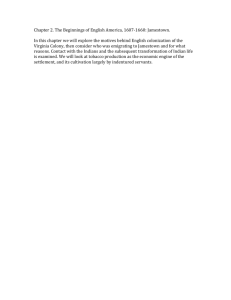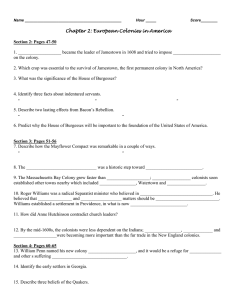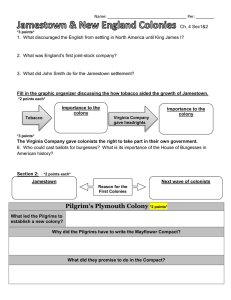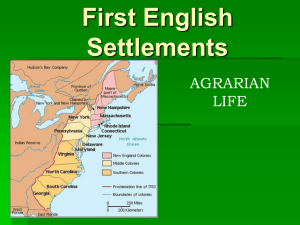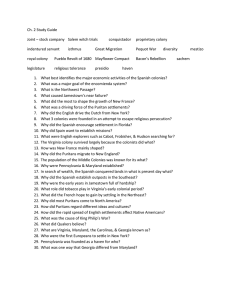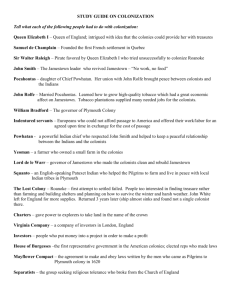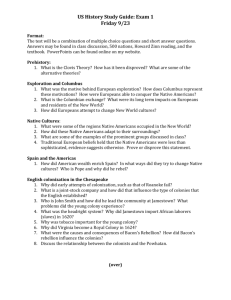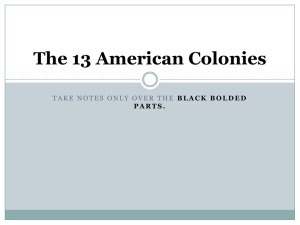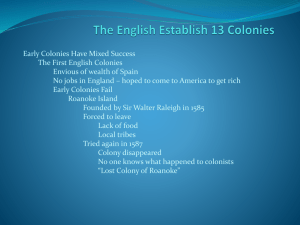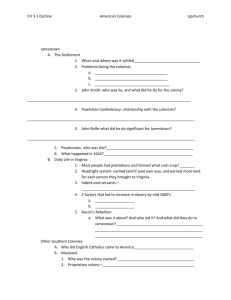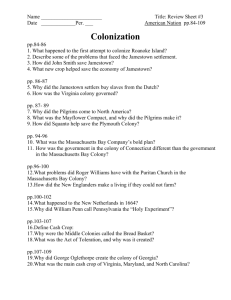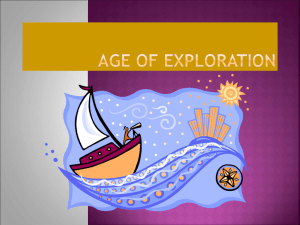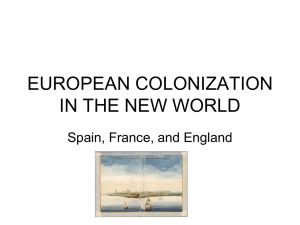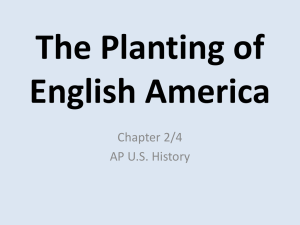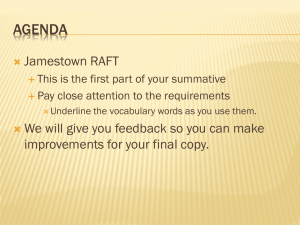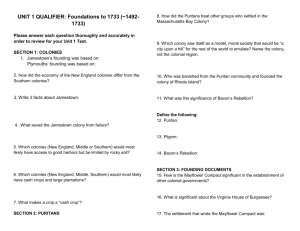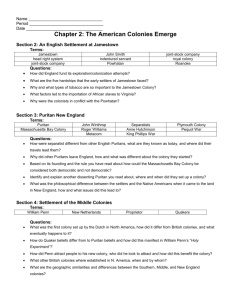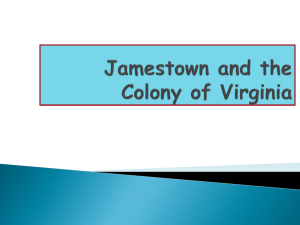1607- jamestown, va
advertisement
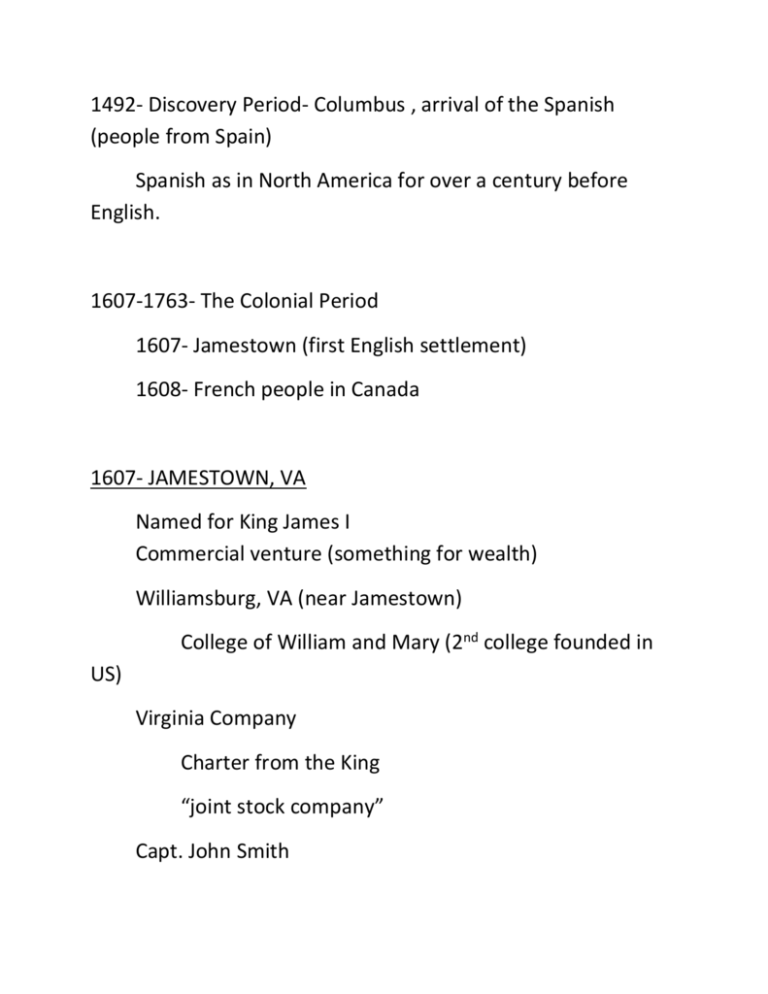
1492- Discovery Period- Columbus , arrival of the Spanish (people from Spain) Spanish as in North America for over a century before English. 1607-1763- The Colonial Period 1607- Jamestown (first English settlement) 1608- French people in Canada 1607- JAMESTOWN, VA Named for King James I Commercial venture (something for wealth) Williamsburg, VA (near Jamestown) College of William and Mary (2nd college founded in US) Virginia Company Charter from the King “joint stock company” Capt. John Smith John Rolfe Made tobacco VA’s “cash crop” European tobacco markets created because of New World crop Married Pocahontas -converted to Christianity (Anglican) -named Lady Rebecca -had son- Thomas - died at 20 in England 1622- Native American uprising in Jamestown vs. the English 1624- King takes over, Jamestown becomes a royal colony where the KING appoints the Governor By 1640- the Africans who came to the New World as INDENTURED SERVANTS were beginning to be treated differently. -terms extended -Children inherited their status (children were servants) -bought and sold 1619- House of Burgesses -representative govt -make colony more appealing to settlers -get accustomed to governing themselves Maryland- 1634 Royal Colony- Lord Baltimore Roman Catholic Colony of Plymouth- 1620 Puritans/Pilgrims “Mayflower”, Thanksgiving William Bradford- Plymouth Plantation 1691- absorbed by the Massachusetts Bay Colony Massachusetts Bay Colony Present- day Boston, MA John Winthrop Public punishment (stocks, Scarlet Letter) 1636- Harvard founded- 1st university in the US Pennsylvania Given to William Penn (Penn’s woods) from King Charles II Quakers (Society of Friends) -no formal clergy - emphasized simplicity -pacifists (don’t believe in war, fighting) Religious tolerance Philadelphia- “city of brotherly love” -well-planned Characteristics of the Colonies in 17th and 18th centuries English speaking, Christian Common law, Represented government- House of Burgesses RURAL- few cities; ties to Europe Slavery in South AND North Women- domestic roles “femme coverte” (legal term)- woman’s identity is attacked to her husband Increasing population in the 18th century More diverse (not just a bunch of English men) Cities: - Less than 10% of the population lives in cities - Largest city- Philadelphia o Important to American Revolution - New York, Boston, Charleston - Commerce- located on the coast or on rivers - Class stratification o Merchants o Shopkeepers o Unskilled workers - Travel between cities is difficult (no/few/bad roads) DIFFERENCE between the Colonies New England - Settled in town Church is the center of town FAMILY is the center of life Longer life span (healthier climate) Religion is important Puritans o Original sin o Accountable to God - Poor farming, strong commerce/business, lumber, shipbuilding, fishing - Trade with British Isles and West Indies - Emphasis on Family and Marriage Middle Colonies (New York, Pennsylvania, New Jersey) - Great diversity (ethnic and religious groups) o Germans o Scotland o Irish o Dutch (NY) o Quakers o Huguenots (French Protestant) - Good soil, trade, fur trade, diverse economy - River system - Moderate climate - Big cities- Philadelphia, New York City Southern Colonies (Virginia, Maryland, Carolinas, Georgia) -plantations, everything is spread out -few cities -high death rates -unsafe drinking water -male dominated society -staple crops: tobacco, indigo (dye), rice (S.C.), lumber -market in England for these product -indentured servants, then slaves -by 1750- most slaves are in Virginia and Maryland -Williamsburg (VA), Charleston (SC) -
